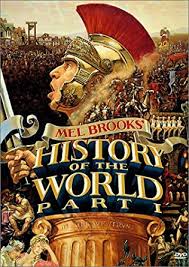Clowning Around
Listen to the Recess! Clip
| Author | John Cech |
| Air Date | 8/5/2003 |

Clowning Around Transcript
It’s International Clown Week, and that has us thinking about this ancient figure, who is the primal source of laughter. Our word for “clown” comes from the old Icelandic, klunni, which meant a clumsy person, and is related to other archaic words for clod, or clump, or, in old Middle High German, klutz. We still use that word today to describe someone who always seems to be tripping over his two left feet.
No one really knows who the first clown was, though Mel Brooks has an answer for that question in his hysterically funny movie, “History of the World Part One,” in which the earliest belly laugh is caused when a cavorting, stand-up caveman comedian gets eaten by a dinosaur in the middle of his monologue — to his tribe’s great amusement. A more likely choice for original clown honors may go to the ice-age drawing of a dancing man wearing a deer’s head, which was discovered in a cave in the south of France by three spelunking boys in the early 1900s. This mysterious figure, who is frequently called the magician or shaman, whose spells could relieve you of illness, is just a few steps away from the “show-man,” whose incantations can relieve you of the pressures of everyday life. The Zunis of the American South West had a name for this creature: he was called the Contrary. He appeared, dressed in a striped costume, wearing a cone-shaped hat, at all the most sacred festivals. His job was to make fun of serious things, to call attention to the absurd, impossible side of our experience and thus to complete a kind of cosmic circle. He reminds us of that other shadowy, tricky, wobbly side to our nature. He was supposed to do what you aren’t supposed to do — fall down, eat the wrong things, say the wrong things, behave the wrong way — everything we were expected to out-grow when we joined the serious adult world. As kids we somehow felt a kind of kinship with this character — after all, to some degree we’d been there ourselves, not too long before. And perhaps that is why so many clowns are child-like, from Baby Hermes to Chaplin, to Robin Williams to Adam Sandler. When you think about it, the job hasn’t changed much in, ohhh, twenty or thirty thousand years.